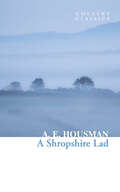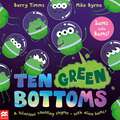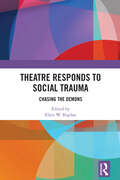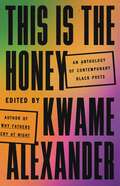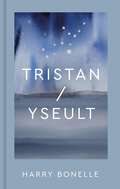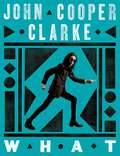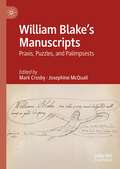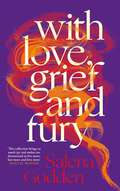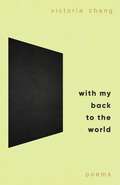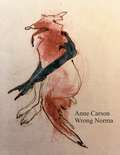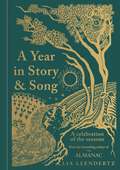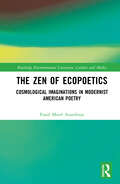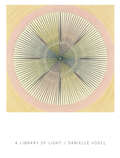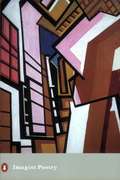- Table View
- List View
A Shropshire Lad (Collins Classics)
by null A.E. HousmanHarperCollins is proud to present its incredible range of best-loved, essential classics. What are those blue remembered hills, What spires, what farms are those? First published in 1896, A.E. Housman’s best-loved collection of poetry is a poignant exploration of love, loss, the inevitable passage of time and the fragility of life. Using elegant melodic simplicity, Housman’s poems arouse profound emotional resonance through their portrayal of an idyllic rural England, evoking a sense of nostalgia and longing for times gone by. A Shropshire Lad became popular with young British soldiers during the First World War and is now widely considered a classic work of English poetry. With lyrical beauty and universal themes, these 63 poems have inspired generations of readers across the world.
Ten Green Bottoms: A laugh-out-loud rhyming counting book
by Barry TimmsCount down from ten with the cheeky aliens and do your 'sums with bums' in Ten Green Bottoms – a hilarious storybook for preschoolers, which is a twist on the classic nursery rhyme Ten Green Bottles. Join the green-bottomed aliens and their ‘wind-powered' rocket as they cause all kinds of mischief on Earth. Packed full of silly humour and with lots to spot in busy scenes, this riotous rhyming story by Barry Timms and Mike Byrne is perfect for reading aloud and sharing.With a surprise gatefold ending, a number line to count up to ten and back down again plus a page of simple adding up, first maths skills have never been so much fun!
Theatre Responds to Social Trauma: Chasing the Demons (Routledge Series in Equity, Diversity, and Inclusion in Theatre and Performance)
This book is a collection of chapters by playwrights, directors, devisers, scholars, and educators whose praxis involves representing, theorizing, and performing social trauma.Chapters explore how psychic catastrophes and ruptures are often embedded in social systems of oppression and forged in zones of conflict within and across national borders. Through multiple lenses and diverse approaches, the authors examine the connections between collective trauma, social identity, and personal struggle. We look at the generational transmission of trauma, socially induced pathologies, and societal re-inscriptions of trauma, from mass incarceration to war-induced psychoses, from gendered violence through racist practices. Collective trauma may shape, protect, and preserve group identity, promoting a sense of cohesion and meaning, even as it shakes individuals through pain. Engaging with communities under significant stress through artistic practice offers a path towards reconstructing the meaning(s) of social trauma, making sense of the past, understanding the present, and re-visioning the future.The chapters combine theoretical and practical work, exploring the conceptual foundations and the artists’ processes as they interrogate the intersections of personal grief and communal mourning, through drama, poetry, and embodied performance.
Theatre Responds to Social Trauma: Chasing the Demons (Routledge Series in Equity, Diversity, and Inclusion in Theatre and Performance)
by Ellen W. KaplanThis book is a collection of chapters by playwrights, directors, devisers, scholars, and educators whose praxis involves representing, theorizing, and performing social trauma.Chapters explore how psychic catastrophes and ruptures are often embedded in social systems of oppression and forged in zones of conflict within and across national borders. Through multiple lenses and diverse approaches, the authors examine the connections between collective trauma, social identity, and personal struggle. We look at the generational transmission of trauma, socially induced pathologies, and societal re-inscriptions of trauma, from mass incarceration to war-induced psychoses, from gendered violence through racist practices. Collective trauma may shape, protect, and preserve group identity, promoting a sense of cohesion and meaning, even as it shakes individuals through pain. Engaging with communities under significant stress through artistic practice offers a path towards reconstructing the meaning(s) of social trauma, making sense of the past, understanding the present, and re-visioning the future.The chapters combine theoretical and practical work, exploring the conceptual foundations and the artists’ processes as they interrogate the intersections of personal grief and communal mourning, through drama, poetry, and embodied performance.
This Is the Honey: An Anthology of Contemporary Black Poets
by Kwame AlexanderA breathtaking poetry collection on hope, heart, and heritage from the most prominent and promising Black poets and writers of our time, edited by #1 New York Times bestselling author Kwame Alexander. In this comprehensive and vibrant poetry anthology, bestselling author and poet Kwame Alexander curates a collection of contemporary anthems at turns tender and piercing and deeply inspiring throughout. Featuring work from well-loved poets such as Rita Dove, Jericho Brown, Warsan Shire, Ross Gay, Tracy K. Smith, Terrance Hayes, Morgan Parker, and Nikki Giovanni, This Is the Honey is a rich and abundant offering of language from the poets giving voice to generations of resilient joy, &“each incantation,&” as Mahogany L. Browne puts it in her titular poem, is &“a jubilee of a people dreaming wildly.&” This essential collection, in the tradition of Dudley Randall&’s The Black Poets and E. Ethelbert Miller&’s In Search of Color Everywhere, contains poems exploring joy, love, origin, race, resistance, and praise. Jacqueline A.Trimble likens &“Black woman joy&” to indigo, tassels, foxes, and peacock plumes. Tyree Daye, Nate Marshall, and Elizabeth Acevedo reflect on the meaning of &“home&” through food, from Cuban rice and beans to fried chicken gizzards. Clint Smith and Cameron Awkward-Rich enfold us in their intimate musings on love and devotion. From a &“jewel in the hand&” (Patricia Spears Jones) to &“butter melting in small pools&” (Elizabeth Alexander), This Is the Honey drips with poignant and delightful imagery, music, and raised fists. Fresh, memorable, and deeply moving, this definitive collection a must-have for any lover of language and a gift for our time.
Tristan/Yseult
by Harry BonelleA duel on an empty island sets the course for one of the greatest romances ever told. As the lovers of legend meet, something new is born, and something eternal is revealed. Their names will forever be spoken as one. This modern retelling of Tristan and Yseult sheds a stark light on the beauty of the Celtic tale.
WHAT
by John Cooper Clarke'Nothing short of dazzling' – Alex TurnerDr John Cooper Clarke's dazzling, scabrous voice has reverberated through pop culture for decades, his influence on generations of performance poets and musicians plain for all to see. In WHAT, the original 'People's Poet' comes storming out of the gate with an uproarious new collection, reminding us why he is one of Britain's most beloved writers and performers. James Brown, John F. Kennedy, Jesus Christ: nobody is safe from the punk rocker's acerbic pen – and that's just the first poem.Hot on the heels of The Luckiest Guy Alive and his sprawling, encyclopaediac memoir I Wanna Be Yours, the good Doctor returns with his most trenchant collection of poems yet. Vivid and alive, with a sensitivity only a writer with a life as varied and extraordinary as Cooper Clarke's could summon, WHAT is an exceptional collection from one of our foremost satirists.
William Blake's Manuscripts: Praxis, Puzzles, and Palimpsests
by Mark Crosby Josephine A. McQuailThis collection of essays examines how close analysis of William Blake’s manuscripts can yield new discoveries about his techniques, his working habits, and his influences. With the introduction of facsimile editions and more particularly, the William Blake Archive, the largest digital repository of Blake materials online, scholars have been able to access Blake’s work in as close its original medium, leading to important insights into Blake’s creative process and mythopoetic system. Recent advancements in digital editing and reproduction has further increased interest in Blake’s manuscripts. This volume brings together both established Blake scholars, including G.E. Bentley Jnr’s final essay on Blake, and upcoming scholars whose research is at the intersection of digital humanities, critical theory, textual scholarship, queer theory, transgender studies, reception history, and bibliographical studies. The chapters seek to cover the breadth of Blake’s manuscripts: poetry, letters, notebook entries, and annotations. Together, these chapters offer an overview of the current state of research in Blake studies on manuscripts at a point when his manuscripts have become increasingly available in digital environments, and gesture to a possible future of Blake scholarship in general.
With Love, Grief and Fury
by Salena GoddenWith Love, Grief and Fury contains love poems, for people and the planet; grief poems brimming with compassion, sharing tears and mourning what was and contemplating what could be; and poems of fire and fury that will kick some ass, tell the truth and inspire change and hope. Over thirty years after she first stormed the UK poetry scene, the trailblazing and award-winning writer Salena Godden has produced her most audacious and definitive collection to date. Like a big sister’s arm around your shoulder, With Love, Grief and Fury is important and nourishing for the soul.
With My Back to the World
by Victoria Chang'Chang has liberated the Ekphrastic form to new lyric heights and depths. Inventive, meditative, audacious, strange and soulful. A marvel of a collection that engages the eye and mind as much as the ear and heart' Raymond AntrobusYesterday I slung my depression on my back and went to the museum. I only asked four attendants where the Agnes painting was and the fifth one knew. I walked into the room and saw it right away. From afar, it was a large white square.WITH MY BACK TO THE WORLD engages with the paintings and writings of Agnes Martin, the celebrated abstract modern artist, in ways that open up new modes of expression, expanding the scope of what art, poetry, and the human mind can do. Filled with surprise and insight, wit and profundity, the book explores the nature of the self, of existence, life and death, grief and depression, time and space. Strikingly original, fluidly strange, Victoria Chang's new collection is a book that speaks to how we see and are seen.
Wrong Norma: ‘I would read anything she wrote’ Susan Sontag
by Anne CarsonWrong Norma is Anne Carson's first book of original material in eight years'If she was a prose writer she would instantly be recognised as a genius'COLM TÓIBÍN, author of Brooklyn'I'm a big fan... She pinpoints the collision of oracle and anachronism'TEJU COLE, author of TremorAs with her most recent publications, Wrong Norma is a facsimile edition of the original hand-designed book, drawn and annotated by the author. Several of the twenty-five startling poetic prose pieces have appeared in magazines and journals like the New Yorker and the Paris Review.Anne Carson is probably our most celebrated living poet, winner of countless awards and routinely tipped for the Nobel Prize in Literature. Famously reticent, asking that her books be published without cover copy, she has agreed to say this:Wrong Norma is a collection of writings about different things, like Joseph Conrad, Guantanamo, Flaubert, snow, poverty, Roget's Thesaurus, my Dad, Saturday night, Sokrates, writing sonnets, forensics, encounters with lovers, the word "idea", the feet of Jesus, and Russian thugs. The pieces are not linked. That's why I've called them "wrong".
A Year in Story and Song: A Celebration of the Seasons
by Lia LeendertzA Year in Story and Song is a captivating collection of stories and songs that celebrates the seasons. We humans love stories. We love to hear them and to tell them, around fires and by bedsides, and we love to use them to make sense of the world around us. The seasons, in all their ever-changing variety, give us many opportunities for storytelling: the full moons and their names, Epiphany in January, St Patrick's Day in March, May Day, Midsummer, Halloween and more. They feature mischievous boggarts and fairies, saints and sailors, leprechauns and dragons, pilgrimages and charms, milk maids and rose queens, Robin Hood and the green man. The songs range from shanties and love songs, to bawdy ballads and wassails, to carols and rounds, and have been sung for hundreds of years, often at particular moments in the calendar.This is a book to treasure all year, every year.
The Zen of Ecopoetics: Cosmological Imaginations in Modernist American Poetry (Routledge Environmental Literature, Culture and Media)
by Enaiê Mairê AzambujaThis book is the first comprehensive study investigating the cultural affinities and resonances of Zen in early twentieth-century American poetry and its contribution to current definitions of ecopoetics, focusing on four key poets: William Carlos Williams, Marianne Moore, Wallace Stevens, and E.E. Cummings. Bringing together a range of texts and perspectives and using an interdisciplinary approach that draws on Eastern and Western philosophies, including Zen and Taoism, posthumanism and new materialism, this book adds to and extends the field of ecocriticism into new debates. Its broad approach, informed by literary studies, ecocriticism, and religious studies, proposes the expansion of ecopoetics to include the relationship between poetic materiality and spirituality. It develops ‘cosmopoetics’ as a new literary-theoretical concept of the poetic imagination as a contemplative means to achieving a deeper understanding of the human interdependence with the non-human. Addressing the critical gap between materialism and spirituality in modernist American poetry, The Zen of Ecopoetics promotes new forms of awareness and understanding about our relationship with non-human beings and environments. It will be of interest to scholars, researchers, and students in ecocriticism, literary theory, poetry, and religious studies.
The Zen of Ecopoetics: Cosmological Imaginations in Modernist American Poetry (Routledge Environmental Literature, Culture and Media)
by Enaiê Mairê AzambujaThis book is the first comprehensive study investigating the cultural affinities and resonances of Zen in early twentieth-century American poetry and its contribution to current definitions of ecopoetics, focusing on four key poets: William Carlos Williams, Marianne Moore, Wallace Stevens, and E.E. Cummings. Bringing together a range of texts and perspectives and using an interdisciplinary approach that draws on Eastern and Western philosophies, including Zen and Taoism, posthumanism and new materialism, this book adds to and extends the field of ecocriticism into new debates. Its broad approach, informed by literary studies, ecocriticism, and religious studies, proposes the expansion of ecopoetics to include the relationship between poetic materiality and spirituality. It develops ‘cosmopoetics’ as a new literary-theoretical concept of the poetic imagination as a contemplative means to achieving a deeper understanding of the human interdependence with the non-human. Addressing the critical gap between materialism and spirituality in modernist American poetry, The Zen of Ecopoetics promotes new forms of awareness and understanding about our relationship with non-human beings and environments. It will be of interest to scholars, researchers, and students in ecocriticism, literary theory, poetry, and religious studies.
A Library of Light (Wesleyan Poetry Series)
by Danielle VogelWhen poet Danielle Vogel began writing meditations on the syntax of earthen and astral light, she had no idea that her mother's tragic death would eclipse the writing of that book, turning her attention to grief's syntax and quiet fields of cellular light in the form of memory. Written in elegant, crystalline prose poems, A Library of Light is a memoir that begins and ends in an incantatory space, one in which light speaks. At the book's center glows a more localized light: the voice of the poet as she reflects, with ceremonial patience, on the bioluminescence of the human body, language's relationship to lineage, her mother's journals written during years of estrangement from her daughter, and the healing potential of poetry. A mesmerizing elegy infused with studies of epigenetic theory and biophotonics, A Library of Light shows that to language is to take part in transmission, transmutation of energy, and sonic (re)patterning of biological light.[sample poem]When we are. When we are there, we lay together and cover ourselves with our voices. When we are ten, we are also twenty-one. We speak of breathing, but this is a thing we cannot do. When we are seven, we are also eighteen. When we are eighteen, we begin our bodies. But we are unmappable,unhinged. A resynchronization of codes, thecrystalline frequencies of stars, seeds, vowels, lying dormant within you. We are the oldest dialect. Asound the voice cannot make but makes.
Imagist Poetry (Penguin Modern Classics)
by Peter JonesImagism was a brief, complex yet influential poetic movement of the early 1900s, a time of reaction against late nineteenth-century poetry which Ezra Pound, one of the key imagist poets, described as ‘a doughy mess of third-hand Keats, Wordsworth … half-melted, lumpy’. In contrast, imagist poetry, although riddled with conflicting definitions, was broadly characterized by brevity, precision, purity of texture and concentration of meaning: as Pound stated, it should ‘use no superfluous word, no adjective, which does not reveal something … it does not use images as ornaments. The image itself is the speech’. It was this freshness and directness of approach which means that, as Peter Jones says in his invaluable Introduction, ‘imagistic ideas still lie at the centre of our poetic practice’.
